[toggle title=’Click to show/hide spoiler’]
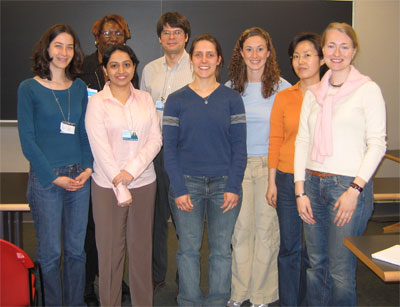
- Joel Gittelsohn, PhD
- Hee-Jung Song, MS
- Sonali Suratkar, MPH
- Cris Franceschini
- Kevin Frick, PhD
- Sharla Jennings, MS
Overview
The Baltimore Healthy Stores project is being led by a research team from the Johns Hopkins Bloomberg School of Public Health working in partnership with the Baltimore City Health Department and interested community organizations. The formative research, funded by the Johns Hopkins Center for a Liveable Future and the The Center for Adolescent Health Promotion and Disease Prevention, helped the team develop and identify barriers to healthy eating in the community and develop strategies to increase access to a nutritionally adequate diet, improve food security, and reduce the risk of diet-related chronic diseases in Baltimore, Maryland.
A pilot trial in Spring 2004 conducted at the Stop, Shop, and Save supermarket in East Baltimore helped the research team to strengthen and refine project messages aimed at store customers. The feasibility trial and its evaluation, funded in part by the Center for Adolescent Health and by the US Department of Agriculture, Food Assistance and Nutrition Research Program, will lay the groundwork for a city-wide grocery store intervention program in the future. The feasibility trial, which began in January 2006, will run through September of 2006.
Urban Demographics and Food Availability
- Race and socio-economic status: A neighborhood’s socioeconomic status and ethnic composition influence the type of stores available to its residents. Wealthy areas inhabited by whites attract large numbers of supermarkets and convenience stores, which offer a wider variety of quality food at lower prices. In contrast, low-income minorities living in inner-cities have to rely on small stores with limited selection of foods offered at higher prices, while increasingly, the few remaining supermarkets close or move to suburban areas (1).
- Availability of Transportation: Lack of transportation and safety concerns further contribute to the difficulties faced by the urban poor to maintain a healthy diet. Cost, location and availability of food have been shown to be significant predictors of dietary choices in low-income populations (2).
- Cost Disparities: Compared to suburban residents who have access to large supermarkets, urban dwellers can pay up to 37% more for groceries in their local communities (1).
Diet and Chronic Disease in Baltimore
- Baltimore city lost 15% of its supermarkets between 2000-2002 (3).
- Residents of areas underserved by bus lines and beset by a host of social problems rely on corner and drug stores for their groceries (3).
- A recent survey of a West Baltimore neighborhood (4) found that 60% of adults were overweight (BMI >25) and 31% were obese (BMI>30).
- Death rates from heart diseases in the city jumped 75% between 1990 and 1999, ranking as the number one cause of death of Baltimore residents in 1999 (26.6%).
- Death rates from diabetes mellitus in African-American populations in Baltimore doubled in the same time period (5).
References
- Morland K, Wing S, Diex-Roux A, Poole C. Neighborhood characteristics associated with the location of food stores and food service places. Am J of Prev Med 2002;22(1):23-9.
- Stokols D. Establishing and maintaining a healthy environment: towards a ocial ecology of health promotion. Am Psychol 1992;54:443-6.
- Klein A. Baltimoreans are hungry for supermarkets. Baltimore Sun, 05/21/2002.
- Clark JM, Bone LR, Stallings R, Gelber AC, Barker A, Zeger S, et al. Obesity and approaches to weight in urban African-American community. Ethn Dis 2001 Fall; 21(4):676-86.
- Baltimore City Health Department. Mortality Statistical Tables.1999. Baltimore, MD: 2000.
Intervention Materials
Communications Materials
- Handouts distributed to participants at store and recreation center sessions.
- Displays, shelf labels, and posters used in corner stores and carryouts as point of purchase promotions
Social Media-Facebook, Instagram, Twitter
- Posting occurred regularly and followed a schedule to maintain follower engagement
Text Messaging
- Text messages sent out 3 times per week to caregivers to reinforce educational messages and goal setting
Youth Mentoring
- Biweekly sessions in recreation centers for children 10-14 years old
Interactive Educational
- Biweekly sessions in recreation centers for children 10-14 years old
Interactive educational sessions and taste tests
- In corner stores, carryouts, and recreation centers
- Sessions included discussion, handouts, giveaways and taste tests
Wholesaler giftcards for initial stocking and promotions of promoted food items
- Via shelf labels and in store circular
- Promoted foods labeled on shelves, BHCK logo highlighted promoted foods on sale in circular
- Owners received a giftcard every subphase to purchase initial stock
Giveaways for participants (water bottles, chip clips, portion bowls)
- Participants received these at recreation center, corner store and carryout interactive sessions to increase awareness of activities and help encourage new healthier behaviors.
Structural changes and incentives to corner stores (e.g. ranging from banana holders to refrigerators)
- Owners earned incentives for watching training videos, bringing in new products, and maintaining shelf labels in the proper location
- Carryouts received new menu boards
Policy changes to institutionalize and sustain intervention components
- Frequent engagement with policymakers through meetings, testimony, and op-eds
Mailings to BHCK families
- Sent out once every two weeks to families and included handouts, recipes, giveaways, challenges to reinforce intervention messages and maintain communication between data collection measures.
Summer Peer Mentoring Program
- Home visits during the summer months by mentors and study staff to continue goal setting with family
- Program involved weekly text messages with mentee, corner store tour, home visits, and weekly phone calls
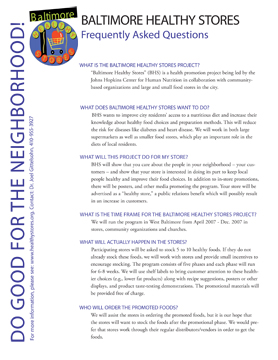


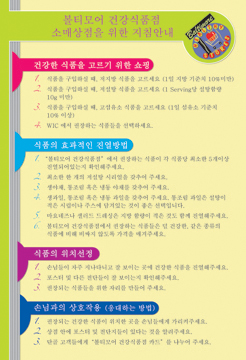
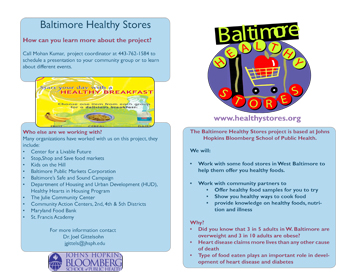
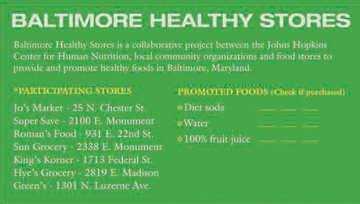
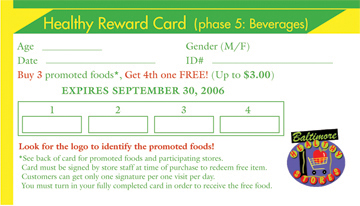
Formative Research Tools / Project Reports / Publications
Formative Research Tools
Manual of Procedures for Conducting Consumer Questionnaire (PDF)
Consumer Screening Form (PDF)
Consumer Questionnaire (PDF)
Food Source Checklist (PDF)
Map of Baltimore City Census Tracts (food source assessment conducted in 11 randomly selected tracts indicated in purple) (jpg)
SCIENTIFIC POSTER: Results of Formative Research for a Food Store-Based Intervention in Baltimore, Maryland (jpg)
Project Reports
Project Update for USDA Grant (PDF)
(March 2006 Report) Evaluation of a feasibility study of a food store-based intervention for low income residents of Baltimore City
Project Update for USDA Grant (PDF, May 2005 Report)
The Baltimore Healthy Stores (BHS) program has made many significant accomplishments in the period of 1/1/2005 to 3/31/2005.
Project Report to The Center for a Livable Future (PDF, January 2005 Report)
Increasing Food Security for the Inner City Population in Baltimore: Formative Research for Food Store-Based Environmental Interventions
Reaching Adolescents through Food Stores (PDF, December 2004 Report)
An Environmental Intervention Program to Improve Diet and Nutrition in East Baltimore
Formative Research on Adolescent Food Choice in Baltimore (PDF, Spring 2004 report)
This paper presents the results of formative research conducted to understand the predominant influences on African American adolescent diet in East Baltimore. Through in-depth interviews, participant observations, focus groups, and a photo diary, we explore adolescent eating habits, definitions of healthy, and environmental and familial influences on food choices.
Baltimore Healthy Stores Community Leaders Workshop (January 16, 2004) Report (PDF)
The second workshop with community leaders provided further opportunities to get needed input for the project’s development from interested partners.
Baltimore Healthy Stores Community Leaders Workshop (November 7, 2003) Report (PDF)
The purpose of the Baltimore Healthy Stores Community Leaders Workshop was to build collaborations and rapport with organizations working to improve health in Baltimore City. This report provides summary results from the first workshop.
Community-based Participatory Research & Baltimore Healthy Stores: Goals, Progress and Future Steps (PDF, January 2004)
This paper discusses the Baltimore Healthy Stores (BHS) project in regards to the adaptation, application and advancement of the community-based participatory research methodology. Baltimore Healthy Stores aims to develop a culturally appropriate and sustainable environmental nutrition intervention in Baltimore City through research methods that engage the community.
The East Baltimore Nutritional Environment: Formative Research with Community Leaders, a Spring 2003 report (PDF)
Slide Show: The Mission, Methods, and Goals Behind the Baltimore Healthy Stores Project (Powerpoint)
Student Report on Formative Research on East Baltimore Corner Stores, Spring 2002 (PDF)
Publications
Gittelsohn J, Franceschini MC, Rasooly I, Ries AV, Ho LS, Pavlovich W, Santos VT, Jennings S and Frick KD. (2007) “Understanding the food environment in a low income urban setting: Implications for food store interventions,” Journal of Hunger & Environmental Nutrition, 2(2/3): 33-50.
Gittelsohn J, Suratkar S, Song H-J, Sacher S, Rajan R, Rasooly IR, Bednarek E, Sharma S and Anliker JA. (2009) “Process evaluation of Baltimore Healthy Stores: A pilot health intervention program with supermarkets and corner stores in Baltimore City,” Health Promotion Practice, Jan 14. [Epub ahead of print].
http://www.ncbi.nlm.nih.gov/pubmed/19144859
Sharma S, Cao X, Arcan C, Mattingly M, Jennings S, Song HJ, Gittelsohn J, (2009) “Assessment of dietary intake in an inner-city African American population and development of a quantitative food frequency questionnaire to highlight foods and nutrients for a nutritional invention,” International Journal of Food Sciences and Nutrition, Apr 8:1-13. [Epub ahead of print]
http://www.ncbi.nlm.nih.gov/pubmed/19353421
Dodson J, Hsiao Y-C, Kasat M, Murray L, Nguyen N, Richards A and Gittelsohn J. (2009) “Formative research for a healthy diet intervention among inner-city adolescents: The importance of family, school and neighborhood environment,” Ecology of Food and Nutrition, 48: 39-58.
http://www.ncbi.nlm.nih.gov/pubmed/21883057
Suratkar S, Gittelsohn J, Song HJ, Sharma S, Anliker JA, Mattingly M*, (2010) “Food insecurity is associated with food-related psychosocial factors and behaviors among low-income African American adults in Baltimore City,” Journal of Hunger and Environmental Nutrition, 5(1): 100-119.
Song HJ*, Gittelsohn J, Kim M, Suratkar S, Sharma S and Anliker JA, (2010) “Korean-American storeowners’ perceived barriers and motivators for implementing a corner store-based nutrition program,” Health Promotion Practice, April 27 [Epub ahead of print]. http://www.ncbi.nlm.nih.gov/pubmed/20424001
Song HJ, Gittelsohn J, Kim M, Suratkar S, Sharma S, Anliker JA, and Mattingly M, “Korean American corner stores in Baltimore City: A key feature of the urban food environment,” (Manuscript submitted to Health Education and Behavior, March 2008).
Gittelsohn J, Song H-J, Suratkar S, Kumar M, Henry EG, Sharma S, Mattingly M, Anliker J, (2009) “An urban food store intervention positively impacts food-related psychosocial variables and food behaviors,” Health Education and Behavior, Nov 3. [Epub ahead of print].
http://www.ncbi.nlm.nih.gov/pubmed/19887625
Song HJ*, Gittelsohn J, Kim M, Suratkar S, Sharma S and Anliker JA, (2009) “A corner store intervention in a low-income urban community is associated with increased availability and sales of some healthy foods” Public Health Nutrition Apr 30:1-8. [Epub ahead of print]. http://www.ncbi.nlm.nih.gov/pubmed/19402943
D’Angelo H, Gittelsohn J, Suratkar S, Song HJ & Stauffer E. (2011) “Access and food source use are associated with healthy and unhealthy food purchasing behaviors among low-income African American adults in Baltimore City.” Public Health Nutrition, Mar 31:1-8. [Epub ahead of print]. http://www.ncbi.nlm.nih.gov/pubmed/21450140
If you would like the data collection forms please email Joel Gittelsohn.
Legal Disclaimer: Under Copyright Law we encourage you to use our materials for personal or educational purposes, provided that a copyright notice accrediting the content to “Dr. Joel Gittelsohn/Johns Hopkins Bloomberg School of Public Health” is attached to the reproduction. No reproduction may be made of any of the artworks from this website for commercial use for any reason without first receiving written permission from Dr. Joel Gittelsohn/Johns Hopkins Bloomberg School of Public Health.
HEALTHY FOOD SYSTEMS
The Healthy Food Systems projects aim to improve health and prevent obesity and disease in low-income communities through culturally appropriate educational, environmental and policy interventions that increase access to healthy foods and promote their purchase, preparation and consumption.
View our Resources
CONTACT INFOMATION
Center for Human Nutrition
Room W2041A
Department of International Health
Johns Hopkins Bloomberg School of Public Health
615 North Wolfe Street
Baltimore, MD. 21205-2179
Work: 410-502-6971
Fax: 410-955-0196
FOLLOW US ONLINE
The Johns Hopkins Bloomberg School of Public Health
B‘More Healthy Communities for Kids (BHCK)
[/toggle]